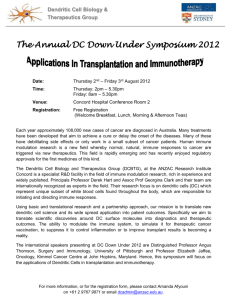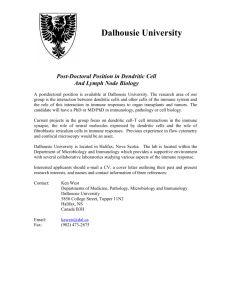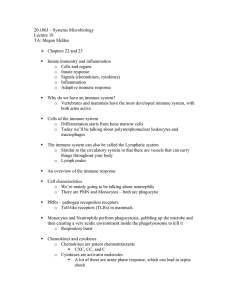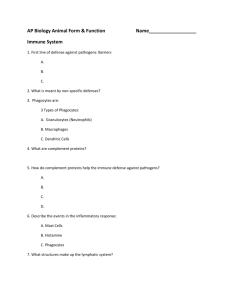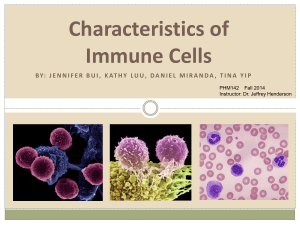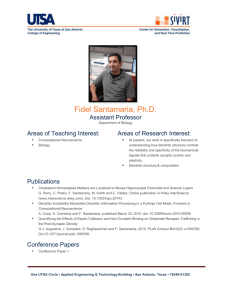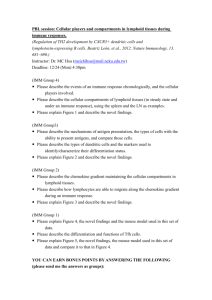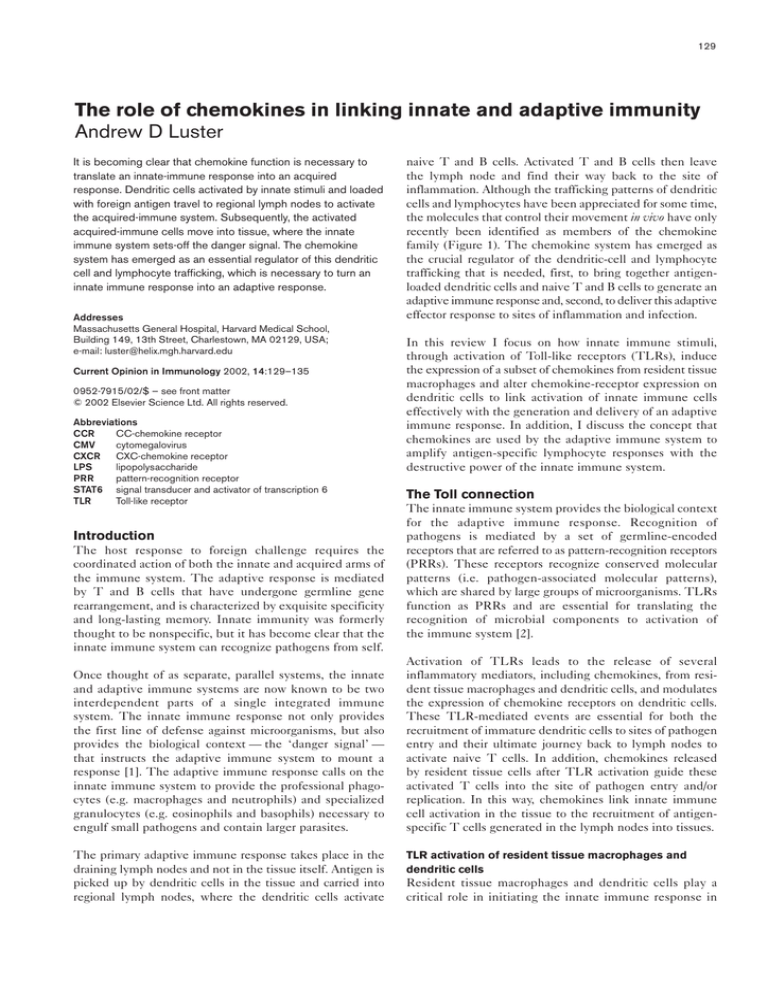
129
The role of chemokines in linking innate and adaptive immunity
Andrew D Luster
It is becoming clear that chemokine function is necessary to
translate an innate-immune response into an acquired
response. Dendritic cells activated by innate stimuli and loaded
with foreign antigen travel to regional lymph nodes to activate
the acquired-immune system. Subsequently, the activated
acquired-immune cells move into tissue, where the innate
immune system sets-off the danger signal. The chemokine
system has emerged as an essential regulator of this dendritic
cell and lymphocyte trafficking, which is necessary to turn an
innate immune response into an adaptive response.
Addresses
Massachusetts General Hospital, Harvard Medical School,
Building 149, 13th Street, Charlestown, MA 02129, USA;
e-mail: luster@helix.mgh.harvard.edu
Current Opinion in Immunology 2002, 14:129–135
0952-7915/02/$ — see front matter
© 2002 Elsevier Science Ltd. All rights reserved.
Abbreviations
CCR
CC-chemokine receptor
CMV
cytomegalovirus
CXCR
CXC-chemokine receptor
LPS
lipopolysaccharide
PRR
pattern-recognition receptor
STAT6 signal transducer and activator of transcription 6
TLR
Toll-like receptor
Introduction
The host response to foreign challenge requires the
coordinated action of both the innate and acquired arms of
the immune system. The adaptive response is mediated
by T and B cells that have undergone germline gene
rearrangement, and is characterized by exquisite specificity
and long-lasting memory. Innate immunity was formerly
thought to be nonspecific, but it has become clear that the
innate immune system can recognize pathogens from self.
Once thought of as separate, parallel systems, the innate
and adaptive immune systems are now known to be two
interdependent parts of a single integrated immune
system. The innate immune response not only provides
the first line of defense against microorganisms, but also
provides the biological context — the ‘danger signal’ —
that instructs the adaptive immune system to mount a
response [1]. The adaptive immune response calls on the
innate immune system to provide the professional phagocytes (e.g. macrophages and neutrophils) and specialized
granulocytes (e.g. eosinophils and basophils) necessary to
engulf small pathogens and contain larger parasites.
The primary adaptive immune response takes place in the
draining lymph nodes and not in the tissue itself. Antigen is
picked up by dendritic cells in the tissue and carried into
regional lymph nodes, where the dendritic cells activate
naive T and B cells. Activated T and B cells then leave
the lymph node and find their way back to the site of
inflammation. Although the trafficking patterns of dendritic
cells and lymphocytes have been appreciated for some time,
the molecules that control their movement in vivo have only
recently been identified as members of the chemokine
family (Figure 1). The chemokine system has emerged as
the crucial regulator of the dendritic-cell and lymphocyte
trafficking that is needed, first, to bring together antigenloaded dendritic cells and naive T and B cells to generate an
adaptive immune response and, second, to deliver this adaptive
effector response to sites of inflammation and infection.
In this review I focus on how innate immune stimuli,
through activation of Toll-like receptors (TLRs), induce
the expression of a subset of chemokines from resident tissue
macrophages and alter chemokine-receptor expression on
dendritic cells to link activation of innate immune cells
effectively with the generation and delivery of an adaptive
immune response. In addition, I discuss the concept that
chemokines are used by the adaptive immune system to
amplify antigen-specific lymphocyte responses with the
destructive power of the innate immune system.
The Toll connection
The innate immune system provides the biological context
for the adaptive immune response. Recognition of
pathogens is mediated by a set of germline-encoded
receptors that are referred to as pattern-recognition receptors
(PRRs). These receptors recognize conserved molecular
patterns (i.e. pathogen-associated molecular patterns),
which are shared by large groups of microorganisms. TLRs
function as PRRs and are essential for translating the
recognition of microbial components to activation of
the immune system [2].
Activation of TLRs leads to the release of several
inflammatory mediators, including chemokines, from resident tissue macrophages and dendritic cells, and modulates
the expression of chemokine receptors on dendritic cells.
These TLR-mediated events are essential for both the
recruitment of immature dendritic cells to sites of pathogen
entry and their ultimate journey back to lymph nodes to
activate naive T cells. In addition, chemokines released
by resident tissue cells after TLR activation guide these
activated T cells into the site of pathogen entry and/or
replication. In this way, chemokines link innate immune
cell activation in the tissue to the recruitment of antigenspecific T cells generated in the lymph nodes into tissues.
TLR activation of resident tissue macrophages and
dendritic cells
Resident tissue macrophages and dendritic cells play a
critical role in initiating the innate immune response in
130
Innate immunity
Figure 1
‘Immature’
dendritic cell
Pathogen
LPS
Activated ‘mature’
dendritic cell
MIP-3α
CCR6
Afferent
lymph
CCR1
CCR5
TLR
CCR7
SLC
MIP-1α
MIP-1β
Tissue
macrophage
Endothelium
lymphatics
IP-10
MIP-1α
MIP-1β
IL-8
Lymph
node
Capillary
endothelium
B-cell follicle
HEV
CXCR5
BLC
CXCR1/2
CCR5
Neutrophil
B
B
DC-CK1
DC-CK1
ELC
B
T
Activated
T cell
ELC
?
CXCR5
NK cell
Blood
SLC
ELC
T
CXCR3
T T
T
CCR7
Blood
B
CXCR5
CCR7
SLC
T-cell zone
CXCR3
Activated
T cell
Efferent
lymph
Current Opinion in Immunology
Chemokines orchestrate the trafficking of dendritic cells, T cells and
B cells needed to generate an immune response. By activating TLRs,
LPS on the surface of bacterial pathogens stimulates the local release
of chemokines such as MIP-1α, MIP-1β, MIP-3α and IP-10. Immature
dendritic cells are attracted to this site through activation of chemokine
receptors, such as CCR1, CCR5 and CCR6, that they constitutively
express. Immature dendritic cells are efficient at picking-up antigen, but
must mature and differentiate into cells that can activate naive T cells.
The local milieu into which the immature dendritic cell is attracted
contains pathogen-associated molecular patterns (e.g. LPS) that are
recognized by PRRs such as CD14 and TLRs, which induce the
differentiation and maturation of dendritic cells into potent antigenpresenting cells. During this process, the dendritic cell downregulates
expression of CCR1, CCR5 and CCR6 and upregulates expression of
CCR7, causing its migration into the afferent lymphatic system. The
CCR7 ligand SLC, which is expressed on the endothelium of the
afferent lymphatic system, plays an important role in directing the
migration of the antigen-loaded mature dendritic cells. Chemokines are
also involved in bringing naive T cells and B cells from blood across
high endothelial venules (HEVs) into the lymph nodes and into contact
with the activated dendritic cell. The molecular details remain to be
elucidated, but it is likely that chemokines such as DC-CK1 and ELC
are important in juxta-positioning these cells in the lymph node. SLC
and ELC are produced from stromal cells in the T-cell zone and BLC is
expressed from stromal cells in the B-cell follicle, helping to guide cells
to T- and B-cell areas, respectively. Some activated T cells
downregulate expression of CCR7 but upregulate CXCR5 and so
become directed toward the follicle to deliver help to B cells, whereas
other activated T cells upregulate CXCR3 and are attracted into
inflamed tissue. T cells that are activated in regional lymph nodes, after
encountering antigen-loaded dendritic cells, subsequently return to
sites of inflammation by sensing chemokine gradients established at
these local sites. Chemokines such as IP-10, which is induced by LPS
and IFN-γ, and a ligand for CXCR3, which is highly expressed on
activated T cells, are believed to be important in this process in
immune responses mediated by Th1 cells.
the tissue. These professional phagocytes express many
PRRs, including CD14, scavenger receptors and TLRs.
These PRRs have the ability to recognize foreign antigens
as pathogens and set in motion the innate immune
response by activating one or more of the TLRs. TLR
activation ultimately leads to the activation of NF-κB —
a key transcription factor that mediates early host
defenses. NF-κB induces a genetic program that is
essential for host defense, including the induction of
a subset of chemokines.
The role of chemokines in linking innate and adaptive immunity Luster
131
Figure 2
TLR activation induces the release of
chemokines from resident macrophages and
dendritic cells (DCs). Pathogens selectively
activate distinct TLRs expressed on resident
tissue macrophages and dendritic cells. For
example, the TLR2−TLR6 or TLR2−TLRX
heterodimers are activated by different microbial
products such as peptidoglycan from Grampositive organisms, and bacterial lipoproteins;
TLR4 is activated by LPS from Gram-negative
bacteria; TLR5 is activated by flagellin; and
TLR9 is activated by bacterial DNA, which
contains unmethylated CpG dinucleotides.
Activation of different TLRs induces the
expression of different sets of chemokines. To
date, it has been shown that activation of TLR2
induces the expression of IL-8, RANTES,
MIP-1α and MIP-1β, whereas activation of
TLR4 induces the expression of IP-10,
RANTES, MIP-1α and MIP-1β. In turn, these
chemokines recruit distinct subsets of
leukocytes. Thus, discrimination of the pathogen
by TLRs, and the subsequent production of a
specific subset of chemokines, may be the first
point at which the immune system tailors its
response to specific pathogens.
Peptidoglycan
lipoproteins Flagellin CpG LPS
TLR2
TLR5
TLR6/X
TLR9
Tissue
macrophage
or
dendritic dell
TLR4
?
?
RANTES
MIP-1α
MIP-1β
IL-8
CXCR1/2
CCR5
CCR1
Neutrophil
Chemokines downstream of TLR activation in macrophages
and dendritic cells include IL-8 (also known as CXCL8),
MIP-1α (CCL3), MIP-1β (CCL4), RANTES (CCL5) and
IP-10 (CXCL10) [3•]. MIP-1α, MIP-1β and RANTES were
found to be induced by agonists of both TLR2 and TLR4
(Figure 2). Interestingly, IP-10 was preferentially induced by
TLR4 agonists (e.g. Escherichia coli lipopolysaccharide
[LPS]), whereas IL-8 was preferentially induced by TLR2specific agonists (e.g. Staphylococcus aureus peptidoglycan and
yeast zymosan). These studies suggest that pathogens can
determine the nature of the immune response through
differential activation of TLRs and the subsequent patterns
of chemokine expression.
The early production of chemokines is essential in shaping the
immune response that follows in the tissue. For example, the
production of IL-8 will induce the recruitment of neutrophils;
MIP-1α and MIP-1β will induce the influx of NK cells,
macrophages and immature dendritic cells; and IP-10 will
guide activated T cells back into tissues. The discrimination of
the pathogen by TLRs and the subsequent production of a
specific subset of chemokines may be the first point at which
the immune system tailors its response to specific pathogens.
The NK-cell connection
The early pathogen-induced release of MIP-1α and MIP-1β
has been shown to be vital for the initial influx of NK cells
into the liver in a murine model of cytomegalovirus (CMV)
[4,5••]. These NK cells are an important source of IFN-γ,
which induces the expression of the chemokines IP-10 and
Mig (CXCL9). In turn, IP-10 and Mig lead to the recruitment
of activated T cells into the liver. Neutralization of Mig in this
IP-10
CXCR3
CCR5
Immature
DC
NK cell
Activated
T cell
Current Opinion in Immunology
model impaired the ability of the host to control CMV
replication and led to increased mortality [5••].
Similar observations have been made studying the role
of chemokines in the host response to the intracellular
protozoal parasite Toxoplasma gondii. Infection by this
parasite induces an early and rapid burst in the production
of MIP-1α and MIP-1β from dendritic cells in infected
tissue [6••]. Recently, my co-worker and I have found that
MIP-1α and MIP-1β recruit IFN-γ-secreting NK cells into
infected tissue in a manner dependent on CC-chemokine
receptor (CCR)5, establishing CCR5 as a critical NK-cell
homing receptor (AD Luster, I Khan, unpublished data).
IFN-γ secreted from NK cells induces the production of
chemokines including IP-10 from resident tissue cells; these
chemokines attract antigen-specific CD4+ and CD8+ lymphocytes into infected tissue to establish organ-specific immunity
[7••]. Thus, analogous to antiviral defenses described for CMV
[5••], the host response to T. gondii requires a ‘chemokine to
cytokine to chemokine’ cascade. This probably represents a
general principle that links the innate and acquired immune
response to intracellular pathogens and is essential for
protective immunity. Chemokines — operating at the level of
recruiting NK cells into tissues and then converting the innate
NK-cell response into a T-cell response through the function of
IFN-γ-inducible chemokines — thus constitute an important
link between the innate and adaptive immune response.
The IP-10 connection
As mentioned above, NK-cell production of IFN-γ is
important in inducing the expression of the IFN-γ-inducible
132
Innate immunity
Figure 3
TLRs on dendritic cells has a key role in linking innate and
adaptive responses. TLR stimulation induces dendritic-cell
maturation, which is characterized by the production of
proinflammatory cytokines, upregulation of co-stimulatory
molecules and altered expression of chemokine receptors
[13]. TLR stimulation occurs when a dendritic cell is likely
to have internalized pathogen-associated antigens.
TLR
Cytoplasm
On
?
Off
?
Nucleus
CCR7
X
CCR1
CCR5
CCR6
Current Opinion in Immunology
TLR activation modulates chemokine-receptor expression on dendritic
cells. The maturation of dendritic cells that is induced by TLR activation
downregulates the expression of CCR1, CCR5 and CCR6, and
upregulates the expression of CCR7. Because TLR stimulation occurs
when a dendritic cell is likely to have internalized pathogen-associated
antigens, this switch in chemokine-receptor expression ensures that
dendritic cells loaded with pathogen-associated antigens leave the
tissue and are attracted into the lymphoid system. This modulation of
chemokine-receptor expression and subsequent pattern of dendritic-cell
migration are crucial for the induction of an adaptive immune response.
chemokines IP-10, Mig and I-TAC (CXCL11). These
chemokines bind to and activate CXC-chemokine receptor
(CXCR)3, which is expressed on activated CD4+ and CD8+
T cells and NK cells, and is important for the recruitment of
these cells into tissues.
IP-10 is also directly induced by bacterial products and
viruses, and therefore may play an early role in recruiting
the first T cells and NK cells into tissue. In fact, in an
allogeneic cardiac transplant model IP-10, but not Mig or
I-TAC, was induced in endothelial cells immediately after
surgical manipulation of the graft [8••]. This early
expression of IP-10 induced by endogenous ‘innate’
danger signals, such as hypoxia or trauma, was found to be
essential for the influx of CXCR3+ NK cells and T cells.
Without IP-10 or CXCR3 function, the grafts showed
markedly increased survival. Interestingly, many endogenous
danger-signaling molecules, such as heat shock proteins,
have been shown to activate TLRs [9].
Modulation of chemokine-receptor expression
The early pathogen-induced release of MIP-1α and MIP-1β
is also involved in attracting immature dendritic cells into the
immediate vicinity of the pathogen. Immature dendritic cells
act as sentinels in the tissue and pick up foreign antigen very
efficiently, but are not yet potent activators of naive T cells
[10]. Dendritic cells have been shown to express TLR-2, -3,
-4, -5, -6 and -9 and respond to various pathogen-associated
molecular patterns, such as LPS, bacterial lipoproteins, peptidoglycan and CpG dinucleotides [11,12]. The activation of
Immature dendritic cells express several chemokine
receptors, including CCR1, CCR5 and CCR6 [14]. These
receptors help to keep the immature dendritic cell in the
tissue. After activation, however, dendritic cells downmodulate the expression of these chemokine receptors and
hence their responsiveness to MIP-1α, MIP-1β and
MIP-3α (CCL20) [15,16]. At the same time, they upregulate the expression of CCR7, allowing them to respond to
SLC (CCL21) and ELC (CCL19) [15,16]. This switch in
chemokine-receptor expression and chemokine responsiveness results in the dendritic cells leaving the tissue,
and being drawn into the lymphatics and ultimately into
the T-cell-rich regions of lymph nodes (Figure 3). This
dendritic-cell migration pattern is vital for the induction of
an adaptive immune response.
Localization of immature dendritic cells
Cells of the dendritic-cell lineage are now known to be the
primary cells responsible for activating naive T and B cells.
Dendritic cells, which are formed in the bone marrow,
must move into tissues to pick up and respond to foreign
antigen. This process is probably under the control of
chemokines, but a single chemokine–chemokine-receptor
pair has not yet emerged as a dominant player in this
process. CCR6 was thought to have a role in this process,
but the impairment of dendritic cell function in CCR6deficient mice has been reported to be limited to the
gastrointestinal tract [17•,18].
In a recent study, treating rats with an amino-terminally
modified form of RANTES that functions as the selective
CCR1 and CCR5 antagonist (Met-RANTES) reduced
baseline numbers of tracheal intraepithelial dendritic cells
by about 50% [19•]. In addition, pretreating the animals
with Met-RANTES before they inhaled an aerosol
containing heat-killed bacteria abolished the rapid influx of
dendritic cells into the epithelium that occurred in untreated
controls. These findings implicate CCR1and CCR5 and
their ligands in the recruitment of immature dendritic-cell
precursors into the resting airway tissue and during acute
bacteria-induced inflammation. But Met-RANTES did
not inhibit the influx of dendritic cells into the airway
epithelium after airway infection with mucosal Sendai
virus or after aerosol challenge in mice that were sensitized
with antigen. Thus, many chemokine–chemokine-receptor pairs may be involved in dendritic-cell recruitment into
the tissue depending on the nature of the eliciting stimulus. Alternatively, different dendritic-cell subsets may
express different chemokine receptors and respond to
different chemokines.
The role of chemokines in linking innate and adaptive immunity Luster
T-cell and B-cell trafficking within lymphoid organs
Although the molecular details remain to be elucidated in
full, the expression of chemokines by lymph-node stroma
and dendritic cells coordinates the juxtaposition of
antigen-loaded dendritic cells with re-circulating T and
B cells. Chemokines that may be involved in this process
include DC-CK1 (CCL18), MDC (CCL22), MIP-3α, SLC
and ELC.
SLC and ELC are expressed by T-zone lymph-node
stroma and dendritic cells, and recruit naive T cells [20,21].
DC-CK1 is expressed by activated mature dendritic cells
and also recruits naive T cells [22]. In contrast, MDC is
induced in Langerhans cells migrating from contact-sensitized skin during maturation into lymph-node dendritic
cells, and chemoattracts antigen-specific T cells but not
naive T cells [23]. BLC is expressed from stromal cells in
the B-cell follicle and brings together CXCR5+ T-helper
cells and B cells [24–27].
Figure 4
Antigen-specific
Th2 lymphocyte
Antigen
CCR3
T cells that are activated in regional lymph nodes after
encounter with activated antigen-loaded dendritic cells are
recruited to sites of inflammation by sensing chemokine
gradients established at these local sites. For Th2 cells,
chemokines induced by Th2 cytokines and regulated by
the transcription factor STAT6 (signal transducer and
activator of transcription 6), such as eotaxins-1, -2 and -3
(CCL11, CCL24 and CCL26, respectively), MDC, TARC
(CCL17) and I-309 (CCL1) appear to control the trafficking of Th2 cells into sites of allergic inflammation [29••].
For Th1 cells, chemokines induced by IFN-γ, including
IP-10, Mig and I-TAC, recruit Th1 cells into tissues.
Chemokines link innate cells to the activation
of adaptive immune cells in the tissue
Once in the tissue, Th2 cells secrete IL-4 and IL-13, and
amplify Th2-cell recruitment by inducing the release of
STAT6-inducible chemokines, which are active on Th2
cells. Interestingly, many of these same chemokines are
also active on eosinophils, basophils and mast cells. In this
way, Th2 cells control the trafficking of eosinophils,
basophils and perhaps mast cells into sites of allergic
inflammation (Figure 4). Thus, activation of adaptive
immune cells in the tissue leads to the production of
chemokines, which recruit innate immune cells into the
tissue. In the case of Th2 inflammation, activation of Th2
Th2
APC
CCR8
CCR4
I-309
MDC
IL-13, IL-4
(TNF, IL-1)
Endothelial cell
Epithelial cell
Macrophage
Eotaxins-1, -2, -3, and MCP-4
Effector-T-cell trafficking to sites of infection and
inflammation
Thus, some activated T cells downregulate CCR7,
upregulate CXCR5, become directed toward the follicle to
instruct B cells in class switching and have been called
‘follicular T cells’ [24,27]. In a Th2-polarizing environment,
other T cells downregulate CCR7, upregulate CCR3,
CCR4 and CCR8, and are attracted into sites of Th2
inflammation. In contrast, in a Th1-polarizing environment,
certain T cells upregulate CXCR3 and CCR5, and are
attracted into sites of Th1 inflammation [28].
133
CCR3
Basophil
CCR3
Eosinophil
Current Opinion in Immunology
Chemokines link the activation of Th2 lymphocytes and tissue
eosinophilia. Antigen-activated CD4+ Th2 cells express IL-4 and IL-13,
which synergize with proinflammatory cytokines such as IL-1 and TNF,
and stimulate from epithelial cells, endothelial cells and tissue
macrophages the production of eosinophil chemoattractants, including
eotaxin-1, eotaxin-2, eotaxin-3 and MCP-4. In turn, these chemokines
attract activated eosinophils and basophils into the tissue, which results
in the hallmarks of allergic diseases. APC, antigen-presenting cell.
cells in tissue leads to the influx of eosinophils, basophils
and mast cells.
Chemokines also link activation of the Th1 adaptive cellular
immunity in the tissue to the innate immune response.
Chemokines are released from cytotoxic CD8+ T lymphocytes
after antigen-specific activation. My co-workers and I have
found that cytotoxic lymphocytes specific for HIV-1, HBV
(hepatitis B virus) or HCV vectorially release large amounts of
MIP-1α, MIP-1β and RANTES from their cytotoxic granules
[30]. The release of chemokines directly onto the infected
cell recruits other inflammatory cells, including professional
phagocytes, to the site of viral replication, amplifying the
response to include innate immune effector cells (Figure 5).
Conclusions
Chemokines are essential for the trafficking of immune
effector cells to sites of infection, and it is becoming
increasingly clear that their function is necessary to
translate an innate immune response into an acquired
134
Innate immunity
Figure 5
Monocyte
CCR5
Antigen-specific CTL
CCR1
NK cell
CCR5
Granulocyte
MIP-1α
MIP-1β
RANTES
Chemokines released from cytotoxic
T lymphocytes (CTLs) localize and amplify the
immune response by recruiting leukocytes to
the site of viral replication. Antigen expressed
on infected cells induces activation of CD8+
CTLs and results in the release of MIP-1α,
MIP-1β and RANTES directly onto the target
cell. The release of these chemokines at the
site of infection also serves as a beacon to
call in additional leukocytes, such as
monocytes/macrophages, granulocytes and
NK cells, resulting in the amplification of the
local immune response.
CCR1
Amplification
Infected cell
CCR3
Current Opinion in Immunology
response. Innate immune stimuli — through activation of
TLRs — set in motion a genetic program that induces the
expression of a subset of chemokines from resident tissue
macrophages and dendritic cells, and modulates the
expression of chemokine receptors on dendritic cells.
These changes in chemokine/chemokine-receptor expression
orchestrate the movement of antigen-loaded dendritic cells
from the tissue into lymphoid tissue to activate naive
T and B cells to initiate the adaptive immune response.
Chemokines downstream of TLR activation also help guide
the newly activated T cells back into the tissue where the
innate immune system first sensed the foreign challenge.
In addition, during secondary immune responses
chemokines induced by antigen-specific lymphocyte
responses recruit innate immune cells into sites of inflammation, serving to amplify the adaptive response with
innate immune effector cells. Thus, chemokines and their
receptors serve a critical function in coordinating the interdependent innate and adaptive immune responses.
Future studies will undoubtedly continue to unravel the
complexity of the chemokine system. It is likely that these
studies will continue to add to our knowledge that the
chemokine system finely regulates leukocyte trafficking
and that this trafficking is critical to immune-cell and
immune-system function.
Acknowledgements
My work is supported by grants from the National Institutes of Health. I
thank Fumi Hayashi and Terry Means for their comments on the manuscript.
References and recommended reading
Papers of particular interest, published within the annual period of review,
have been highlighted as:
• of special interest
•• of outstanding interest
1.
Gallucci S, Matzinger P: Danger signals: SOS to the immune
system. Curr Opin Immunol 2001, 13:114-119.
2.
Akira S, Takeda K, Kaisho T: Toll-like receptors: critical proteins
linking innate and acquired immunity. Nat Immunol 2001,
2:675-680.
3.
•
Re F, Strominger JL: Toll-like receptor 2 (TLR2) and TLR4
differentially activate human dendritic cells. J Biol Chem 2001,
276:37692-37699.
This study demonstrates that TLR2 and TLR4 induce the expression of
different sets of cytokines and chemokines, and suggests that pathogen
discrimination by TLRs and the subsequent production of specific subsets
of chemokines may be the first point at which the immune system tailors its
response to specific pathogens.
4.
Salazar-Mather TP, Orange JS, Biron CA: Early murine
cytomegalovirus (MCMV) infection induces liver natural killer (NK)
cell inflammation and protection through macrophage
α (MIP-1α
α)-dependent pathways. J Exp
inflammatory protein 1α
Med 1998, 187:1-14.
5.
••
Salazar-Mather TP, Hamilton TA, Biron CA: A chemokine-tocytokine-to-chemokine cascade critical in antiviral defense. J Clin
Invest 2000, 105:985-993.
The authors find that CMV-induced expression of MIP-1α and MIP-1β
leads to the recruitment of IFN-γ-secreting NK cells into the liver, which
in turn induces the production of Mig and IP-10. These two cytokines
then recruit activated antigen-specific lymphocytes into the liver. Thus,
chemokine-induced recruitment of NK cells links the innate and acquired
immune response.
6.
••
Aliberti J, Reis e Sousa C, Schito M, Hieny S, Wells T, Huffnagle GB,
Sher A: CCR5 provides a signal for microbial induced
α+ dendritic cells. Nat Immunol
production of IL-12 by CD8α
2000, 1:83-87.
CCR5 is essential for the production of IL-12 from dendritic cells activated
by T. gondii. This parasite directly induces the production of MIP-1α and
MIP-1β from dendritic cells, thereby establishing early chemokine gradients
in infected tissue that shape the nature of the immune response.
The role of chemokines in linking innate and adaptive immunity Luster
Khan I, MacLean JA, Lee F, Casciotti L, DeHaan E, Schwartzman J,
Luster AD: The IP-10 chemokine is critical for effector T cell
trafficking and host survival in Toxoplasma gondii infection.
Immunity 2000, 12:483-494.
Infection with T. gondii induces the early expression of IP-10, which is
essential for T-cell trafficking and function in infected tissues. Thus, early
pathogen-induced production of IP-10 is essential for an adaptive, protective
immune response.
hypersensitivity and delayed-type hypersensitivity responses.
J Clin Invest 2001, 107:R37-R45.
7.
••
8.
••
Hancock WW, Gao W, Csizmadia V, Faia K, Shemmeri N, Luster AD:
Donor-derived IP-10 initiates development of acute allograft
rejection. J Exp Med 2001, 193:975-980.
‘Endogenous danger signals’ released from cardiac allografts after
transplantation induce the expression of IP-10 in the donor graft. This IP-10
expression plays an important role in the recruitment of lymphocytes into the
graft and in subsequent graft rejection.
9.
Ohashi K, Burkart V, Flohe S, Kolb H: Heat shock protein 60 is a
putative endogenous ligand of the Toll-like receptor-4 complex.
J Immunol 2000, 164:558-561.
10. Banchereau J, Steinman RM: Dendritic cells and the control of
immunity. Nature 1998, 392:245-252.
11. Muzio M, Mantovani A: Toll-like receptors. Microbes Infect 2000,
2:251-255.
12. Muzio M, Bosisio D, Polentarutti N, D’Amico G, Stoppacciaro A,
Mancinelli R, van’t Veer C, Penton-Rol G, Ruco LP, Allavena P et al.:
Differential expression and regulation of Toll-like receptors (TLR)
in human leukocytes: selective expression of TLR3 in dendritic
cells. J Immunol 2000, 164:5998-6004.
13. Michelsen KS, Aicher A, Mohaupt M, Hartung T, Dimmeler S,
Kirschning CJ, Schumann RR: The role of Toll-like receptors (TLRs)
in bacteria-induced maturation of murine dendritic cells (DCS).
Peptidoglycan and lipoteichoic acid are inducers of DC
maturation and require TLR2. J Biol Chem 2001,
276:25680-25686.
14. Sozzani S, Allavena P, Vecchi A, Mantovani A: Chemokines and
dendritic cell traffic. J Clin Immunol 2000, 20:151-160.
15. Dieu MC, Vanbervliet B, Vicari A, Bridon JM, Oldham E, Ait-Yahia S,
Briere F, Zlotnik A, Lebecque S, Caux C: Selective recruitment of
immature and mature dendritic cells by distinct chemokines
expressed in different anatomic sites. J Exp Med 1998,
188:373-383.
16. Sozzani S, Allavena P, D’Amico G, Luini W, Bianchi G, Kataura M,
Imai T, Yoshie O, Bonecchi R, Mantovani A: Differential regulation of
chemokine receptors during dendritic cell maturation: a model for
their trafficking properties. J Immunol 1998, 161:1083-1086.
17.
•
Cook DN, Prosser DM, Forster R, Zhang J, Kuklin NA, Abbondanzo SJ,
Niu XD, Chen SC, Manfra DJ, Wiekowski MT et al.: CCR6 mediates
dendritic cell localization, lymphocyte homeostasis, and immune
responses in mucosal tissue. Immunity 2000, 12:495-503.
CCR6–/– mice have the selective absence of myeloid dendritic cells in the
subepithelial dome of Peyer’s patches, demonstrating that chemokines
control the trafficking of dendritic cells into mucosal surfaces where they first
encounter foreign antigens.
18. Varona R, Villares R, Carramolino L, Goya I, Zaballos A, Gutierrez J,
Torres M, Martinez AC, Marquez G: CCR6-deficient mice have
impaired leukocyte homeostasis and altered contact
135
19. Stumbles PA, Strickland DH, Pimm CL, Proksch SF, Marsh AM,
•
McWilliam AS, Bosco A, Tobagus I, Thomas JA, Napoli S et al.:
Regulation of dendritic cell recruitment into resting and inflamed
airway epithelium: use of alternative chemokine receptors as a
function of inducing stimulus. J Immunol 2001, 167:228-234.
This study implicates CCR1, CCR5 and their ligands in the recruitment of
immature dendritic-cell precursors into resting airway tissue and during acute
bacteria-induced inflammation, but not after viral or allergen challenge. Thus,
depending on the nature of the eliciting stimulus, several chemokine—chemokinereceptor pairs may be involved in dendritic-cell recruitment into tissue.
20. Ngo VN, Tang L, Cyster JG: Epstein–Barr virus-induced molecule 1
ligand chemokine is expressed by dendritic cells in lymphoid
tissue and strongly attracts naive T cells and activated B cells.
J Exp Med 1998, 188:181-191.
21. Luther SA, Tang HL, Hyman PL, Farr AG, Cyster JG: Coexpression of
the chemokines ELC and SLC by T zone stromal cells and
deletion of the ELC gene in the plt/plt mouse. Proc Natl Acad Sci
USA 2000, 97:12694-12699.
22. Adema GJ, Hartgers F, Verstraten R, de Vries E, Marland G, Menon S,
Foster J, Xu Y, Nooyen P, McClanahan T et al.: A dendritic-cellderived C-C chemokine that preferentially attracts naive T cells.
Nature 1997, 387:713-717.
23. Tang H, Cyster J: Chemokine up regulation and activated T cell
attraction by maturing dendritic cells. Science 1999, 284:819-822.
24. Kim CH, Rott LS, Clark-Lewis I, Campbell DJ, Wu L, Butcher EC:
Subspecialization of CXCR5+ T cells. B helper activity is focused
in a germinal center-localized subset of CXCR5+ T cells. J Exp
Med 2001, 193:1373-1382.
25. Forster R, Mattis AE, Kremmer E, Wolf E, Brem G, Lipp M: A putative
chemokine receptor, BLR1, directs B cell migration to defined
lmphoid organs and specific anatomic compartments of the
spleen. Cell 1996, 87:1037-1047.
26. Ansel KM, Ngo VN, Hyman PL, Luther SA, Forster R, Sedgwick JD,
Browning JL, Lipp M, Cyster JG: A chemokine-driven positive
feedback loop organizes lymphoid follicles. Nature 2000,
406:309-314.
27.
Schaerli P, Willimann K, Lang AB, Lipp M, Loetscher P, Moser B: CXC
chemokine receptor 5 expression defines follicular homing T cells
with B cell helper function. J Exp Med 2000, 192:1553-1562.
28. Sallusto F, Lenig D, Mackay CR, Lanzavecchia A: Flexible programs
of chemokine receptor expression on human polarized T helper 1
and T helper 2 lymphocytes. J Exp Med 1998, 187:875-883.
29. Mathew A, MacLean JA, DeHaan E, Tager AM, Green FH, Luster AD:
•• Signal transducer and activator of transcription 6 controls
chemokine production and T helper cell type 2 cell trafficking in
allergic pulmonary inflammation. J Exp Med 2001, 193:1087-1096.
This study demonstrates that Th2 cell trafficking to the allergic lung is an
active process that depends on STAT6 signaling in the lung. In addition, it
suggests that chemokines regulated by STAT6 control Th2 cell trafficking.
30. Wagner L, Yang OO, Garcia-Zepeda EA, Ge Y, Kalams S, Walker BD,
Pasternack M, Luster AD: β-Chemokines are released from HIV-1
specific cytolytic T-cell granules complexed to proteoglycans.
Nature 1998, 391:908-911.

